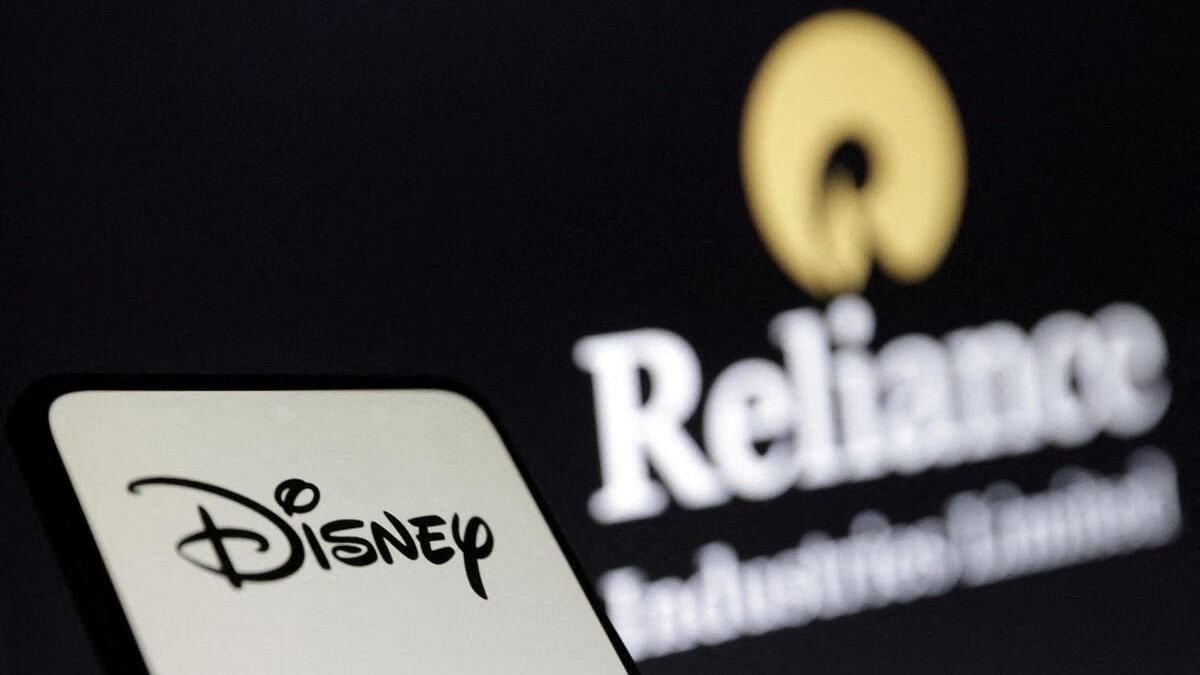
Disney and Reliance logos are seen in this illustration..
Credit: Reuters File Photo
Earlier this year, Reliance Industries Limited and The Walt Disney Company announced a merger of their media and entertainment operations in India. The merged entity, valued at approximately $8.5 billion, would control around 100 television channels and extensive digital streaming (over-the-top) OTT businesses. Under the terms of the agreement, Reliance, through its media subsidiary Viacom, will hold a majority stake in the new entity, while Disney will retain a minority stake of roughly 36%. With this merger, it is poised to create a media behemoth that controls a substantial share of the TV and streaming advertising markets, raising critical questions about the future of competition and consumer protection.
Media reports observe that this has triggered significant scrutiny from the Competition Commission of India (CCI). The regulator's primary concern revolves around the combined entity's potential dominance over cricket broadcast rights — a market with unparalleled influence in India, a country where cricket isn't just a sport but a cultural phenomenon, and a daily need.
Cricket's hold on the Indian populace is reflected in the nearly $2 billion spent on sports-related sponsorships, endorsements, and media in 2023, with cricket accounting for a staggering 87% of that figure. The merged entity would command a 40% share of the advertising market in TV and streaming segments, and with it, a potentially unassailable grip on a lucrative and growing industry.
The CCI's initial assessment suggests that such consolidation could severely undermine competition, particularly as the combined entity would hold the rights to broadcast both domestic and international cricket matches as well as the Indian Premier League (IPL), which alone is worth billions of dollars.
This monopoly over cricket broadcasting has immediate implications for advertisers, who could face steep price increases once the merger solidifies. The merged entity's strategy of offering marquee cricket matches for free on streaming platforms could be seen as a short-term gambit designed to expand its subscriber base. But what happens when the competition dwindles, and the pricing power becomes more concentrated? Consumers may initially benefit from lower prices or even free content, but the long-term scenario could see the disappearance of viable alternatives.
In a market where capital, influence, and access converge, the true test of regulation is not in preventing mergers, but in safeguarding the future of competition and consumer choice long after the ink has dried. Balancing the protection of Indian domestic ownership with the needs of an increasingly hooked-to-consumption economy, while nurturing competition and safeguarding consumer interests, is a delicate act — one that demands foresight, fairness, and an unwavering commitment to the long-term health of the market.
Media reports that in response to CCI queries, Reliance and Disney have proposed divesting fewer than 10 television channels — a move aimed at easing the regulator's concerns. However, they have remained steadfast in retaining their cricket broadcasting rights, arguing that these rights, which expire in 2027 and 2028 for different formats of the game, cannot be sold without the cricket board's approval — a process that could significantly delay any divestiture.
This situation places the CCI in a challenging position. If the CCI insists on a breakup to prevent monopolistic dominance, the question remains whether such a move would genuinely fragment the market. Wouldn't these assets, if divested, simply be absorbed by other entities aligned with the merged giants, only to be re-consolidated over time? Call it ‘Collabtition’, where friends buy or warehouse such assets. The influence of capital, consumer access, and policy connections in India is strong, and history suggests that large conglomerates have ways of navigating regulatory hurdles, with sufficient face savers for all stakeholders.
Moreover, Indian regulators have historically been more inclined to allow deep-pocketed domestic entities to acquire and retain Indian assets, often in the name of national interest or economic stability. To be fair to Indian conglomerates, it is time that Indian policies help in domestic protectionism, considering that Indian consumption economy is set to grow leaps and bounds, and it is fair to have Indian entities reap the benefits of it, simply as it goes downstream to retail investors, vendors, consumers, etc.
Will navigating the CCI's queries lead to a further valuation discount for the Indian entity in this deal, while still allowing it to proceed? Are these CCI concerns rooted in genuine anti-monopoly principles, or is this merely a procedural step — one that much of the market has already discounted, assuming it to be the latter?
As this merger faces its next steps, the CCI's role will be closely watched, not just for its decision on this particular deal, but for what it signifies about the future of competition and consumer protection in India's rapidly evolving media landscape. If it does intervene, what guarantees are there that the market won't simply rearrange itself in favour of the same players in the long run?
In industries like airlines and telecom, where duopolies persist with little governmental or regulatory concern, should we not apply the same logic to media and entertainment? Are these sectors merely a precursor to what we might see in media — a reflection of future trends rather than an exception? These are questions that will define not only the outcome of this merger, also but India's media and entertainment industry for years to come.
(Srinath Sridharan is a policy researcher and corporate adviser. X: @ssmumbai.)
Disclaimer: The views expressed above are the author's own. They do not necessarily reflect the views of DH.